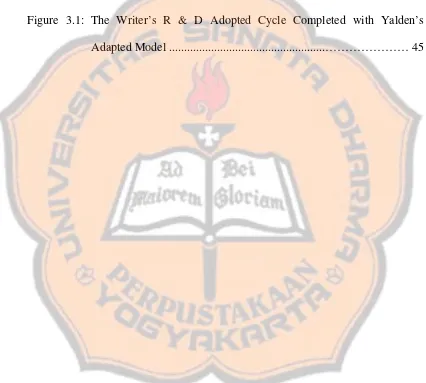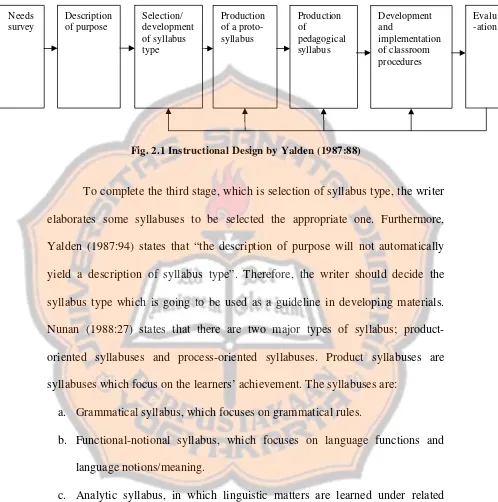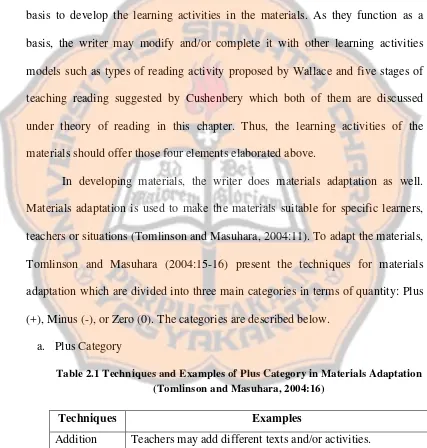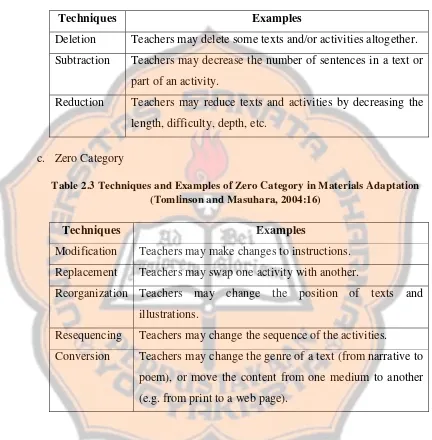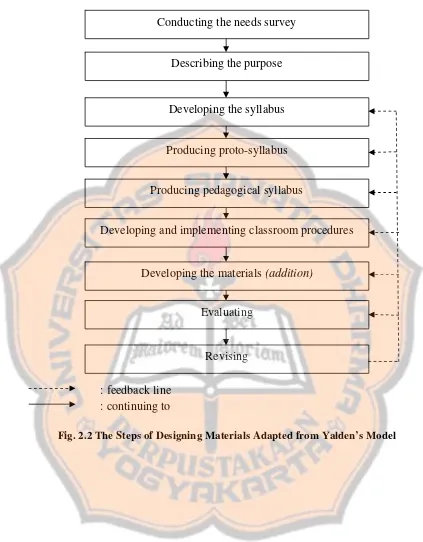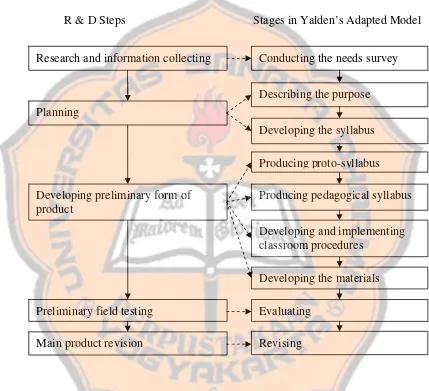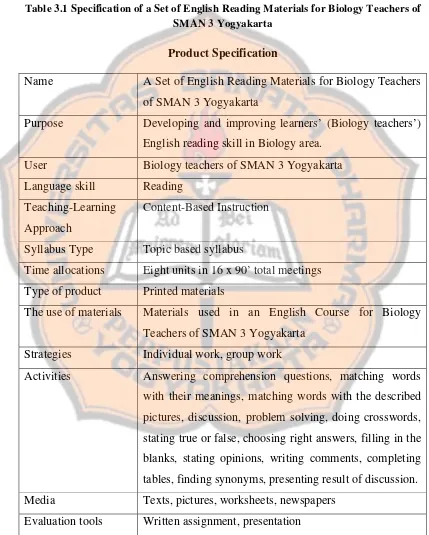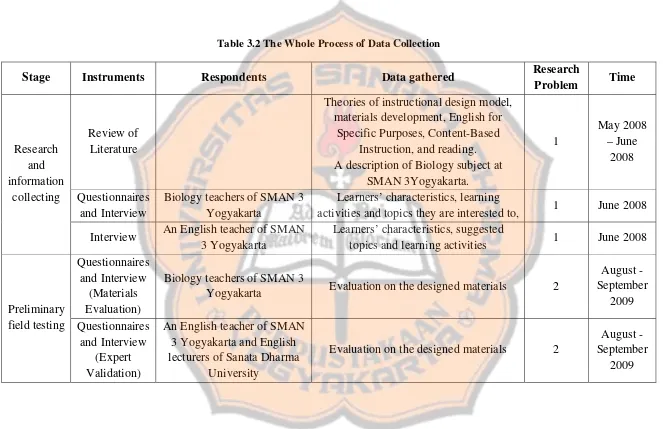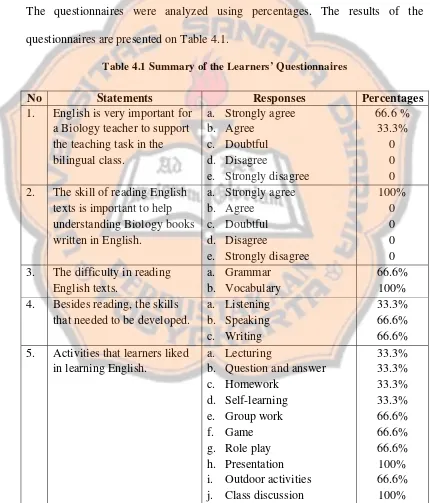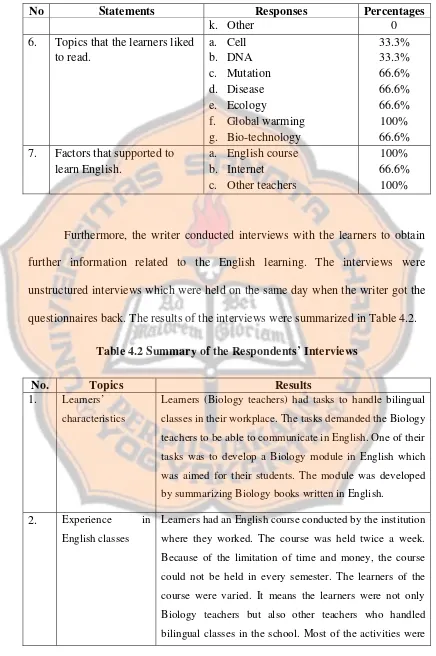ABSTRACT
Afikawati, Leoni. 2010. Designing a Set of English Reading Materials Using Content Based Instruction for Biology Teachers of SMAN 3 Yogyakarta. Yogyakarta: English Language Education Study Program, Sanata Dharma University.
As English becomes lingua franca among people of different nations, government of Education Ministry in Indonesia places English as one of the compulsory subjects at schools. To make English learning effective, some schools in Indonesia utilize English as lingua franca in delivering materials of some school subjects other than English subject. One of the schools is SMAN 3 Yogyakarta. This school policy requires teachers other than English teachers to develop their English proficiencies. Apparently, reading skill plays important role for the teachers who always need to keep up-to-date information in order to support their teaching task. The writer discovers that Biology teachers of the school need to establish their reading skill for there are a lot of English written works dealing with Biology and for accomplishing the demands as teachers in the school. Therefore, the research is aimed at developing a set of English reading materials which is appropriate for Biology teachers of SMAN 3 Yogyakarta. Furthermore, the reading materials are expected to help them develop their English reading skills.
There were two problems formulated in the research. The problems were (1) How is a set of English reading materials for Biology teachers of SMAN 3 Yogyakarta designed? and (2) What does the designed set of materials look like?.
To answer the first research problem, the writer employed some steps on Educational Research and Development (R & D) method which were completed with adapted steps from Yalden’s Model. The steps were (1) reviewing the literature, (2) conducting the needs survey, (3) describing the purposes, (4) developing the syllabus, (5) producing proto-syllabus, (6) producing pedagogical syllabus, (7) developing and implementing classroom procedures, (8) developing materials, (9) evaluating the designed materials, and (10) revising the designed materials.
In the research, the data was obtained through the needs survey. The results of the needs survey were the basis to develop the materials. Having completed with designing materials, the designed materials were evaluated by some English lecturers, an English teacher of SMAN 3 Yogyakarta, and the Biology teachers. The description of the evaluation was in percentages. In addition, the writer also used qualitative data analysis to describe the results of the evaluation. The data showed that the designed materials were acceptable and well-developed although there were some revisions needed. Some suggestions and evaluation of the designed materials were the basis for revising the designed materials.
The presentation of the final version of the designed materials was the answer to the second research problem. The designed set of English reading materials consists of eight units, namely, Biology as Science, Reproduction, HIV-AIDS, Mercury, Alzheimer’s Disease, Bio-technology, Natural Disaster, and Global Warming. Each unit of the designed materials contains of four sections. The sections are Bring It to Mind, Let’s Start, Grammar Battle, and Completing Mission.
Finally, the writer expects that the designed set of English reading materials for Biology teachers of SMAN 3 Yogyakarta could give benefits for those who need it especially for English instructor and the learners (Biology teachers).
ABSTRAK
Afikawati, Leoni. 2010. Designing a Set of English Reading Materials Using Content Based Instruction for Biology Teachers of SMAN 3 Yogyakarta. Yogyakarta: Program Studi Pendidikan Bahasa Inggris, Universitas Sanata Dharma.
Dengan Bahasa Inggris digunakan sebagai bahasa pengantar antar umat manusia dari berbagai negara, pemerintah yang berada di Departemen Pendidikan Indonesia menempatkan Bahasa Inggris sebagai salah satu mata pelajaran wajib di sekolah-sekolah. Agar pembelajaran Bahasa Inggris efektif, beberapa sekolah di Indonesia menggunakan Bahasa Inggris sebagai bahasa pengantar dalam menyampaikan materi di beberapa mata pelajaran sekolah selain dalam pelajaran Bahasa Inggris itu sendiri. Salah satu dari beberapa sekolah tersebut adalah SMAN 3 Yogyakarta. Kebijakan sekolah ini mengharuskan guru-guru yang bukan guru Bahasa Inggris untuk mengembangkan kemampuan Bahasa Inggris mereka. Ternyata, kemampuan membaca berperan penting bagi guru-guru tersebut yang selalu memerlukan informasi yang up-to-date untuk mendukung tugas mengajar mereka. Penulis mendapati bahwa guru-guru Biologi di sekolah tersebut perlu mengembangkan kemampuan membaca karena banyak terdapat karya tulis dalam Bahasa Inggris yang berhubungan dengan Biologi dan karena untuk memenuhi kewajiban mereka sebagai guru di sekolah tersebut. Oleh karena itu, penelitian ini bertujuan untuk mengembangkan seperangkat materi membaca yang sesuai bagi guru-guru Biologi di SMAN 3 Yogyakarta. Selanjutnya, materi membaca ini diharapkan dapat membantu mengembangkan kemampuan membaca Bahasa Inggris mereka.
Ada dua rumusan masalah dalam penelitian ini. Rumusan masalah tersebut adalah (1) Bagaimana seperangkat materi membaca Bahasa Inggris untuk guru-guru Biologi di SMAN 3 Yogyakarta dirancang? dan (2) Bagaimana penyajian seperangkat materi membaca Bahasa Inggris yang telah tersusun?.
Untuk menjawab rumusan masalah yang pertama, penulis menggunakan beberapa langkah dalam metode Educational Research and Development (R & D) yang telah dilengkapi dengan langkah-langkah dari model Yalden yang telah disesuaikan. Langkah-langkah tersebut adalah (1) meninjau pustaka, (2) melakukan survei kebutuhan, (3) menentukan tujuan, (4) mengembangkan silabus, (5) membuat proto-silabus, (6) membuat silabus pedagogik, (7) mengembangkan dan memasukkan prosedur kelas, (8) menyusun materi, (9) mengevaluasi materi, dan (10) memperbaiki materi.
Dalam penelitian ini, data diperoleh dari survei kebutuhan. Hasil dari survei kebutuhan merupakan dasar untuk menyusun materi. Setelah selesai, materi yang telah tersusun dievaluasi oleh beberapa dosen Bahasa Inggris, seorang guru Bahasa Inggris dari SMAN 3 Yogyakarta, dan guru-guru Biologi tersebut. Pemaparan evaluasi tersebut disajikan dalam bentuk prosentase. Sebagai tambahan, penulis juga menggunakan analisis data kualitatif untuk memaparkan
hasil evaluasi. Data menunjukkan bahwa materi yang telah tersusun diterima dan tersusun dengan baik meskipun perlu dilakukan perbaikan. Beberapa saran dan evaluasi dari materi yang telah tersusun adalah dasar untuk memperbaiki materi.
Presentasi materi versi akhir merupakan jawaban dari rumusan masalah kedua. Seperangkat materi membaca Bahasa Inggris terdiri dari delapan unit, yaitu, Biology as Science, Reproduction, HIV-AIDS, Mercury, Alzheimer’s Disease, Bio-technology, Natural Disaster, dan Global Warming. Tiap unit dari materi terdapat empat bagian. Bagian-bagian itu adalah Bring It to Mind, Let’s Start, Grammar Battle, dan Completing Mission.
Akhir kata, penulis berharap bahwa seperangkat materi membaca Bahasa Inggris untuk guru-guru Biologi SMAN 3 Yogyakarta dapat memberikan manfaat bagi mereka yang memerlukannya terutama bagi instruktur Bahasa Inggris dan pelajar (guru-guru Biologi).
DESIGNING A SET OF ENGLISH READING MATERIALS
USING CONTENT BASED INSTRUCTION FOR BIOLOGY
TEACHERS OF SMAN 3 YOGYAKARTA
A THESIS
Presented as Partial Fulfillment of the Requirements to Obtain the Sarjana Pendidikan Degree
in English Language Education
By
Leoni Afikawati Student Number: 041214046
ENGLISH LANGUAGE EDUCATION STUDY PROGRAM DEPARTMENT OF LANGUAGE AND ARTS EDUCATION FACULTY OF TEACHERS TRAINING AND EDUCATION
SANATA DHARMA UNIVERSITY YOGYAKARTA
j{xÇ lÉâ UxÄ|xäx
Performed by Mariah Carey and Whitney Houston
Many nights we’ve prayed with no proof anyone could hear In our hearts a hopeful song we barely understood Now we are not afraid although we know there’s so much pain
We were moving mountains long before we knew we could
There can be miracles when you believe though hope is frail it’s hard to kill Who knows what miracles you can achieve when you believe somehow you will
You will when you believe
In this time of fear when prayer so often proves in vain Hope seemed like the summer birds too swiftly flown away Yet now I’m standing here, my heart’s so full I can’t explain
Seeking faith and speaking words I never thought I’d say
They don’t always happen when you ask and it’s easy to give in to your fears But when you’re blinded by your pain, can’t see your way clear through the rain
A small, but still, resilient voice says help is very near
I dedicated this thesis to Jesus Christ,
my beloved family, my truly best friend, and
those who keep supporting me
ABSTRACT
Afikawati, Leoni. 2010. Designing a Set of English Reading Materials Using Content Based Instruction for Biology Teachers of SMAN 3 Yogyakarta. Yogyakarta: English Language Education Study Program, Sanata Dharma University.
As English becomes lingua franca among people of different nations, government of Education Ministry in Indonesia places English as one of the compulsory subjects at schools. To make English learning effective, some schools in Indonesia utilize English as lingua franca in delivering materials of some school subjects other than English subject. One of the schools is SMAN 3 Yogyakarta. This school policy requires teachers other than English teachers to develop their English proficiencies. Apparently, reading skill plays important role for the teachers who always need to keep up-to-date information in order to support their teaching task. The writer discovers that Biology teachers of the school need to establish their reading skill for there are a lot of English written works dealing with Biology and for accomplishing the demands as teachers in the school. Therefore, the research is aimed at developing a set of English reading materials which is appropriate for Biology teachers of SMAN 3 Yogyakarta. Furthermore, the reading materials are expected to help them develop their English reading skills.
There were two problems formulated in the research. The problems were (1) How is a set of English reading materials for Biology teachers of SMAN 3 Yogyakarta designed? and (2) What does the designed set of materials look like?.
To answer the first research problem, the writer employed some steps on Educational Research and Development (R & D) method which were completed with adapted steps from Yalden’s Model. The steps were (1) reviewing the literature, (2) conducting the needs survey, (3) describing the purposes, (4) developing the syllabus, (5) producing proto-syllabus, (6) producing pedagogical syllabus, (7) developing and implementing classroom procedures, (8) developing materials, (9) evaluating the designed materials, and (10) revising the designed materials.
In the research, the data was obtained through the needs survey. The results of the needs survey were the basis to develop the materials. Having completed with designing materials, the designed materials were evaluated by some English lecturers, an English teacher of SMAN 3 Yogyakarta, and the Biology teachers. The description of the evaluation was in percentages. In addition, the writer also used qualitative data analysis to describe the results of the evaluation. The data showed that the designed materials were acceptable and well-developed although there were some revisions needed. Some suggestions and evaluation of the designed materials were the basis for revising the designed materials.
The presentation of the final version of the designed materials was the answer to the second research problem. The designed set of English reading materials consists of eight units, namely, Biology as Science, Reproduction, HIV-AIDS, Mercury, Alzheimer’s Disease, Bio-technology, Natural Disaster, and Global Warming. Each unit of the designed materials contains of four sections. The sections are Bring It to Mind, Let’s Start, Grammar Battle, and Completing Mission.
Finally, the writer expects that the designed set of English reading materials for Biology teachers of SMAN 3 Yogyakarta could give benefits for those who need it especially for English instructor and the learners (Biology teachers).
ABSTRAK
Afikawati, Leoni. 2010. Designing a Set of English Reading Materials Using Content Based Instruction for Biology Teachers of SMAN 3 Yogyakarta. Yogyakarta: Program Studi Pendidikan Bahasa Inggris, Universitas Sanata Dharma.
Dengan Bahasa Inggris digunakan sebagai bahasa pengantar antar umat manusia dari berbagai negara, pemerintah yang berada di Departemen Pendidikan Indonesia menempatkan Bahasa Inggris sebagai salah satu mata pelajaran wajib di sekolah-sekolah. Agar pembelajaran Bahasa Inggris efektif, beberapa sekolah di Indonesia menggunakan Bahasa Inggris sebagai bahasa pengantar dalam menyampaikan materi di beberapa mata pelajaran sekolah selain dalam pelajaran Bahasa Inggris itu sendiri. Salah satu dari beberapa sekolah tersebut adalah SMAN 3 Yogyakarta. Kebijakan sekolah ini mengharuskan guru-guru yang bukan guru Bahasa Inggris untuk mengembangkan kemampuan Bahasa Inggris mereka. Ternyata, kemampuan membaca berperan penting bagi guru-guru tersebut yang selalu memerlukan informasi yang up-to-date untuk mendukung tugas mengajar mereka. Penulis mendapati bahwa guru-guru Biologi di sekolah tersebut perlu mengembangkan kemampuan membaca karena banyak terdapat karya tulis dalam Bahasa Inggris yang berhubungan dengan Biologi dan karena untuk memenuhi kewajiban mereka sebagai guru di sekolah tersebut. Oleh karena itu, penelitian ini bertujuan untuk mengembangkan seperangkat materi membaca yang sesuai bagi guru-guru Biologi di SMAN 3 Yogyakarta. Selanjutnya, materi membaca ini diharapkan dapat membantu mengembangkan kemampuan membaca Bahasa Inggris mereka.
Ada dua rumusan masalah dalam penelitian ini. Rumusan masalah tersebut adalah (1) Bagaimana seperangkat materi membaca Bahasa Inggris untuk guru-guru Biologi di SMAN 3 Yogyakarta dirancang? dan (2) Bagaimana penyajian seperangkat materi membaca Bahasa Inggris yang telah tersusun?.
Untuk menjawab rumusan masalah yang pertama, penulis menggunakan beberapa langkah dalam metode Educational Research and Development (R & D) yang telah dilengkapi dengan langkah-langkah dari model Yalden yang telah disesuaikan. Langkah-langkah tersebut adalah (1) meninjau pustaka, (2) melakukan survei kebutuhan, (3) menentukan tujuan, (4) mengembangkan silabus, (5) membuat proto-silabus, (6) membuat silabus pedagogik, (7) mengembangkan dan memasukkan prosedur kelas, (8) menyusun materi, (9) mengevaluasi materi, dan (10) memperbaiki materi.
Dalam penelitian ini, data diperoleh dari survei kebutuhan. Hasil dari survei kebutuhan merupakan dasar untuk menyusun materi. Setelah selesai, materi yang telah tersusun dievaluasi oleh beberapa dosen Bahasa Inggris, seorang guru Bahasa Inggris dari SMAN 3 Yogyakarta, dan guru-guru Biologi tersebut. Pemaparan evaluasi tersebut disajikan dalam bentuk prosentase. Sebagai tambahan, penulis juga menggunakan analisis data kualitatif untuk memaparkan
hasil evaluasi. Data menunjukkan bahwa materi yang telah tersusun diterima dan tersusun dengan baik meskipun perlu dilakukan perbaikan. Beberapa saran dan evaluasi dari materi yang telah tersusun adalah dasar untuk memperbaiki materi.
Presentasi materi versi akhir merupakan jawaban dari rumusan masalah kedua. Seperangkat materi membaca Bahasa Inggris terdiri dari delapan unit, yaitu, Biology as Science, Reproduction, HIV-AIDS, Mercury, Alzheimer’s Disease, Bio-technology, Natural Disaster, dan Global Warming. Tiap unit dari materi terdapat empat bagian. Bagian-bagian itu adalah Bring It to Mind, Let’s Start, Grammar Battle, dan Completing Mission.
Akhir kata, penulis berharap bahwa seperangkat materi membaca Bahasa Inggris untuk guru-guru Biologi SMAN 3 Yogyakarta dapat memberikan manfaat bagi mereka yang memerlukannya terutama bagi instruktur Bahasa Inggris dan pelajar (guru-guru Biologi).
ACKNOWLEDGEMENTS
First of all, I would like to praise our Lord, Jesus Christ for all His
blessings, love and guidance in every single step I take. In particular, my
admiration is addressed for the strength He granted to me to accomplish my study
at Sanata Dharma University. Additionally, I would like to give my honor to the
greatest and holy woman in the universe, Mother Mary, for always being with
me during the saddest and happiest times in my great life.
Second, I would like to thank my inspiring parents, Bapak Petrus Silam
and Ibu Rini Sudarwati, for their endless supports, care and love in every second
of my life. For my beloved brother (Leona Pantamareta) and sisters (Leonanda
Nilam Putranti and Leonita Senwa Mayla), thanks for giving me little sunshine
in my days. For my truly best friend, Ana Humardhiana, thanks for always being
there for me, for bitter-sweet moments we share together, and for all the precious
things I owe that cannot be measured only by world’s things.
I dedicate my deepest gratitude to my sponsor, Dr. Retno Muljani,
M.Pd., for the guidance, advice, and corrections to improve my thesis, and for the
patience, care and encouragement to accomplish my thesis. I would also like to
thank to PBI’s teaching staff for educating me during my college years. For Mbak
Tari and Mbak Dani, thanks for providing me with amazing assistance in the
period of studying at PBI. For all the respondents of my research, thanks for the
help, willingness and cooperation to improve the designed materials.
My special thanks go to all my friends in PBI especially those who are
from the year of 2004 that I cannot mention one by one, thanks for accompanying
me in the struggling times completing my study. For all my friends in Catholic
Community, thanks for the supports and all the things we laugh at together. I
would like to thank Mbak Reni, Mbak Kolifah, Yuli, Rita, Wahyu, Anton and
Lukas for being my sisters and brothers who guide me to be the more mature me
and for the good and bad times we share. My gratitude also goes to Ana’s family
who keep supporting me to accomplish my thesis soon. I would like also to say
thank you to Mas Nug for the help, willingness to understand me, and trying to
always be there for me. My very special thank goes Mas Prast for the ongoing
support and care, for all the times we had been together, and for colouring my life.
Last but not least, I would like to say thank you to everyone who helps me
throughout the great times in accomplishing my thesis.
Leoni Afikawati
TABLE OF CONTENTS
TITLE PAGE ... .i
APPROVAL PAGES ... ii
DEDICATION PAGE... .iv
STATEMENT OF WORK’S ORIGINALITY ...v
ABSTRACT... vi
ABSTRAK... viii
PUBLICATION PAGE...x
ACKNOWLEDGMENTS ... .xi
TABLE OF CONTENTS... xiii
LIST OF TABLES ... xvii
LIST OF FIGURES ... xviii
LIST OF APPENDICES ... xix
CHAPTER I. INTRODUCTION 1
A. Research Background ...1
B. Problem Formulation ...5
C. Problem Limitation ...5
D. Research Objectives...6
F. Research Benefits ...7
G. Definition of Terms ...8
CHAPTER II. THEORETICAL REVIEW 10
A. Theoretical Descriptions ...10
1. Yalden’s Instructional Design ...10
2. Materials Development...14
3. English for Specific Purposes (ESP) ...18
a. ESP Methodology ...19
b. Needs Analysis...21
4. Content Based Instruction (CBI) ...23
a. Objectives of CBI...24
b. Characteristics of CBI...24
c. Principles of CBI...27
d. The Role of Learners and Teachers ...27
5. Reading ...28
a. The Nature of Reading ...28
b. Reading in the Content Area...29
c. Types of Reading Activity ...31
d. Reading Techniques...33
6. Biology Subject at SMAN 3 Yogyakarta ...34
B. Theoretical Framework ...36
CHAPTER III. METHODOLOGY 41
A. Research Method ...41
1. Research and Information Collecting ...42
2. Planning ...43
3. Developing Preliminary Form of Product ...43
4. Preliminary Field Testing ...44
5. Main Product Revision ...44
B. Research Participants ...47
D. Research Instruments ...48
1. Questionnaire Sheet ...48
2. Interview Guidelines...49
E. Data Gathering Technique ...49
F. Data Analysis Technique...52
F. Research Procedure ...53
CHAPTER IV. RESULTS AND DISCUSSIONS 56
A. The Steps in Designing the Materials ...56
1. Reviewing the Literature ...57
2. Conducting the Needs Survey ...57
3. Describing the Purposes ...62
4. Developing the Syllabus ...62
5. Producing Proto-Syllabus ...63
6. Producing Pedagogical Syllabus ...68
7. Developing and Implementing Classroom Procedures...69
8. Developing the Materials...75
9. Evaluating the Designed Materials...76
10. Revising the Designed Materials ...85
B. The Presentation of the Designed Materials ...86
CHAPTER V. CONCLUSIONS AND SUGGESTIONS 93
A. Conclusions ...93
B. Suggestions...94
REFERENCES...96
LIST OF TABLES
Table 2.1: Techniques and Examples of Plus Category...……… 16
Table 2.2: Techniques and Examples of Minus Category ……… 17
Table 2.3: Techniques and Examples of Zero Category……… 17
Table 3.1: Specification of the Designed Materials……… ...…………46
Table 3.2: The Whole Process of Data Collection...51
Table 4.1: Summary of the Learners’ Questionnaires…… ...……… 58
Table 4.2: Summary of the Respondents’ Interviews……… 59
Table 4.3: Summary of the English Teacher’s Interview……… . 61
Table 4.4: The Topics of the Designed Materials… .……… 64
Table 4.5: The Learning Materials of the Designed Materials……… .………… 64
Table 4.6: The Learning Indicators of the Designed Materials ……… 66
Table 4.7: The Words in the Designed Materials .……… 68
Table 4.8: Results of the Expert Validation ..……… 77
Table 4.9: Results of the Expert Validation in Percentages..……… 80
Table 4.10: The Strengths and the Weaknesses of the Designed Materials...81
Table 4.11: Results of the Learners’ Evaluation……… 83
Table 4.12: Results of the Learners’ Evaluation in Percentages……… 83
Table 4.13: The Presentation of the Designed Materials….. ……… 86
LIST OF FIGURES
Figure 2.1: Instructional Design by Yalden………...………....13
Figure 2.2: The Steps of Designing Materials Adapted from Yalden’s Model...40
Figure 3.1: The Writer’s R & D Adopted Cycle Completed with Yalden’s
Adapted Model ...……… 45
LIST OF APPENDICES
Appendix 1: Letters of Permission...……… 98
Appendix 2: Questionnaire for Needs Analysis...……… 100
Appendix 3: Evaluation Questionnaire………… ...………… 103
Appendix 4: Questionnaire for Expert Validation ...105
Appendix 5: Overview of the Designed Set of Materials………… ...……108
Appendix 6: Syllabus and Lesson Plans…… ...……… 111
Appendix 7: Presentation of the Designed Set of the Materials
CHAPTER I
INTRODUCTION
This chapter consists of six parts. They are the research background,
problem formulation, problem limitation, objectives of the research, research
benefits and definition of terms used in the research.
A. Research Background
English, todays, is not merely a language which is used by its native
speakers. It now widely spread around the world as a result of international trade,
travel, and industry (McKay, 2002: 18). English is essential for those who deal
with such international activities to share information, ideas, knowledge, and so
on. Since English becomes lingua franca to communicate among people of
different nations, people are required to be able to understand and use English as
an access to enter world communication.
Indonesia, as a developing country, needs not only natural resources but
also human resources which are important to maintain the elements of
development. Qualified human resources are needed to keep this country in
progress and to answer many problems that occur in this country. Beside
mastering their own specialities, they are demanded to be able to interact with
people from other countries. According to McKay (2002: 15-16),
“By the beginning of the nineteenth century Britain had become the world’s leading industrial and trading nation. Most of the innovations of the Industrial Revolution were of British origin, resulting in new terminology
for technological and scientific advance. Hence, those who wanted to learn more about these innovations needed English both to understand the new terminology and talk to English speaking inventors and manufacturers.”
Thus, English has important role in this globalization era.
Because English is neither mother tongue nor lingua franca among
Indonesian, it needs to be learned and practiced. Moreover, Graddol (McKay,
2002: 18) notes “Today over 84 per cent of the internet servers are English
medium…. These figures clearly demonstrate that one needs to know English
today in order to access and contribute to both printed and electronic
information.” Considering the matter, both governmental and non-governmental
schools place English as a compulsory school subject. In addition, to improve
education quality, some schools in Indonesia have used English as a language to
convey information in certain school subjects other than English. The schools
attempt to apply an international standard of education so that the students and/or
the graduates can compete with others in the international level (Astika, 2009).
Moreover, some regulations have been made by government of Indonesia as the
foundations of the presence of SBI (Sekolah Bertaraf Internasional) in Indonesia. To achieve the purpose of SBI, as stated above, the schools conduct
bilingual classes for some school subjects. However, there are some problems that
occur in carrying out bilingual classes. According to Astika (2009), one of the
problems is the unprepared teachers to use English as the lingua franca in class. Although the portion of using English in bilingual classes is not as much as in
English class, teachers of those subjects should learn English to avoid
demand. Thus, some schools which apply SBI conduct English courses for the teachers to overcome the problem.
In recent days, the bilingual classes are still limited to some certain
subjects. Some of the subjects include Math, Physics and Biology. Here, the
writer focuses her research on English course for teachers of Biology. The writer
also perceives that Biology is chosen because it uses more verbal language than
other those subjects which mostly use numbers and there are always up-to-date
English written works related to it which can be obtained easily. As a matter of
fact, Biology teachers are stillat the beginning level of English proficiency. Based
on the survey (Astika, 2009), 33.3% of bilingual teachers do not have ability to
communicate in English. Meanwhile, they are expected to be able to communicate
in English for their profession’s demand and improvement of education quality.
Therefore, they should be at least able to read and understand English texts since
there are many written works related to Biology that are offered. This is essential
for them to enrich their knowledge and to help them support their teaching tasks.
Furthermore, as bilingual teachers, they have a task to develop learning materials
in English. In developing the materials, teachers may modify the available books
written in English. Here, they will employ their reading skills in completing the
task. For these reasons, it is obvious that people use English not only for
communicative purposes but also for specific purposes in order to deepen their
knowledge in certain field and to accomplish their profession’s demand.
According to Hutchinson and Waters (1987: 19), “English for specific
and method are based on the learner’s reason for learning”. It means that the
topics and the kind of teaching learning process are based on the learner’s needs.
The need to learn English in specific purposes will appear when they find
difficulties in reading English texts. In this research, the texts are related to
Biology so that the English learning will be much meaningful to Biology teachers
as the learners. Regarding with the reason stated above, the writer attempts to
design a set of English reading materials for Biology teachers. Besides, there has
not been such material available yet.
In conclusion, the reasons of deciding to design a set of English reading
materials for Biology teachers are based on three considerations. First, the school
policy requires Biology teachers to also use English in class as a means of
communication. Second, many written works related to Biology which are
important to support teaching-learning process are written in English. Third, the
writer discovers that most Biology teachers are still at the beginning level of
English proficiency. Therefore, the materials are designed as a guideline to help
the learners understand English text.
By designing a set of English reading materials for Biology teachers, the
writer expects the materials will be helpful for them in order to comprehend many
written works in English and to increase their reading skill. Furthermore, they will
enrich their knowledge to support their teaching tasks in bilingual classes for the
B. Problem Formulation
In the research, there are two main problems that the writer is going to
solve. The two problems can be formulated as follows:
1. How is a set of English reading materials using Content Based Instruction
(CBI) for Biology teachers of SMAN 3 Yogyakarta designed?
2. What does the designed set of English reading materials using Content
Based Instruction (CBI) for Biology teachers of SMAN 3 Yogyakarta look
like?
C. Problem Limitation
The research is limited to the discussion on designing a set of English
reading materials using CBI for Biology teachers of SMAN 3 Yogyakarta. As
stated in the research background, there are three main reasons why the writer
chooses Biology subject as her research object. First, only certain classes use
English as a lingua franca in class other than English. One of them is Biology.
Second, Biology uses more verbal language than the other two subjects mentioned
in the research background which have tendency to arithmetic. Last, there are a lot
of up-to-date written works related to Biology which can be obtained easily, and
the works are closely related to our daily life as human beings.
Apparently, the existence of schools which utilize English in teaching
learning processes of school subjects other than English subject has not widely
spread yet in Yogyakarta. For example, SMAN 3 Yogyakarta is one of some
Negeri 3 Yogyakarta states that the school starts to apply Kelas Rintisan SMA Bertaraf Internasional (SBI) in the school year of 2006-2007. It also states that only some school subjects such as Math, Physics, and Biology which have been
applied that program. Thus, it can be understood why the research is designed for
SMA Negeri 3 Yogyakarta.
Also, the research is concerned with the appropriate English reading
materials for Biology teachers. Reading materials play an important role toward
the comprehension of English texts. According to Hutchinson and Waters (1987:
107), “materials help to organize the teaching and learning process by providing a
path through the complex mass of the language to be learnt”. Since there is no
particular material yet for Biology teachers which can help them to learn how to
understand and comprehend English texts in their field, it is necessary to design
suitable materials which are focused on reading in order to answer the needs of
the Biology teachers.
D. Research Objectives
Considering the problems which have been stated in the problem
formulation, the research is conducted to achieve the following objectives:
1. to discover how a set of English reading materials using CBI for Biology
teachers of SMAN 3 Yogyakarta is designed.
2. to present the designed set of English reading materials using CBI for
E. Research Benefits
The research is intended to give benefits to a particular scientific area,
especially English for Biology teachers. Therefore, the findings of the research are
expected to bring valuable contributions to:
1. Biology teachers
They are provided with a set of English reading materials that help them to
understand English texts in Biology field. Furthermore, it is expected that
they will be motivated in reading English texts that are useful to enrich their
knowledge dealing with their field.
2. English instructors
They are provided with a set of English reading materials which can be
utilized to teach an English course for Biology teachers.
3. Others who concern with the field
By reading a set of English reading materials for Biology teachers, people
can gain information from the texts while they improve their English reading
skill.
4. Future researchers
They can learn from the research how to design a set of English reading
materials for Biology teachers and later if they are willing to evaluate,
F. Definition of Terms
There are five key terms which are used in the research, they are:
1. Design
Based on Oxford Advanced Learner’s Dictionary (1995: 314), design is “a drawing or an outline from which something may be made”. Meanwhile, Trochim
(2006) states that “A design is used to structure the research, to show how all of
the major parts of the research project … work together to try to address the
central research questions.”. Here, design is a plan which is mentioned to facilitate
intended subject that is Biology teachers to help them in language learning
process.
2. Reading materials
According to Wallace (1992:3), “reading is an awareness of the way in
which we use language”. Meanwhile, Nunan (1989:33) states that “reading is an
interactive process between what a reader already knows about a given topic or
subject and what the writer writes”. The writer concludes that reading is a skill to
obtain information and writer’s message from text with aid of the readers’
background knowledge and awareness of language use. Thus, reading materials
are materials to be used in language teaching activities in reading class in which
there are learning objectives, reading texts, learning activities, learning indicators,
and learning evaluation.
3. Content Based Instruction (CBI)
Content Based Instruction is “the integration of particular content with
second language skills but also maintaining the learners’ knowledge of a
particular subject at once. Thus, knowledge of language and knowledge of subject
matter which is Biology in the research are developed simultaneously.
4. Biology Teachers
From an online Biology Dictionary (2007), Biology is defined as the scientific study of the life; science that studies living world, living organisms and
the phenomena, and characteristics of life processes. Teachers are persons who
teach; especially those who teach in schools. It means that Biology teachers are a
group of persons or people who teach the scientific study dealing with living
things.
5. SMAN 3 Yogyakarta
SMAN 3 Yogyakarta is one of senior high schools in Yogyakarta. Like
other senior high schools, this school also has aim which is to prepare the students
to continue their education to the higher level. The school is located at Jl. Yos
CHAPTER II
THEORETICAL REVIEW
There are two major sections that are going to be discussed in this chapter.
They are the theoretical descriptions which contain reviews on related theories to
answer the research problems and the theoretical framework which underlies the
research.
A. Theoretical Descriptions
In this section, the writer elaborates five groups of theory and a description
which will be used to develop a set of English reading materials for Biology
teachers. Those are theory of instructional design, theory of materials
development, theory of English for Specific Purposes (ESP), theory of
Content-Based Instruction (CBI), theory of reading, and a description of Biology subject at
SMAN 3 Yogyakarta.
1. Yalden’s Instructional Design
In accomplishing the research, the writer applied Yalden’s instructional
design. As language is a means of communication, Yalden’s model is chosen for it
takes communicative needs of the learners into account and it is sufficiently
flexible providing that there is a recycling stage in the cycle. This model presents
structured stages consisting of specified tasks needed to do by the writer in
designing the materials. The stages refer to the stages of how to develop a
language program in which there is a stage to develop syllabus. Since there is no
stage to develop materials clearly presented in Yalden’s model, the research needs
materials development theory to support this model which is presented in the next
discussion.
The stages in a language program development proposed by Yalden (1987:
88-89) are as follows:
a. Needs survey
This step is aimed to collect information from the target learners which will
be used as a consideration for describing the learning purposes. Needs
survey can be carried out by distributing questionnaires and/or interviewing.
b. Description of purpose
Having conducted the needs survey, the writer’s task is to describe the
purpose of learning. Learning purposes will underlie the development of
syllabus and the content of designed materials.
c. Selection/development of syllabus type
This stage is the stage to produce a syllabus. According to Yalden (1987:85),
a syllabus is a stage at which specified content of language course is
organized. In developing a syllabus, the writer should consider the needs of
learners so that it can meet the learners’ goal. Thus, here, the writer
perceives that a syllabus is a guideline to develop a set of English teaching
d. Production of a proto-syllabus
This stage is a step in which the content of syllabus is specified. It may
include general notions and specific topics, communicative functions,
discourse and rhetorical skills, variety of language, role-sets, and
communicative events, as well as grammar and lexis.
e. Production of a pedagogical syllabus
At this stage, the writer specifies words and phrases which are suitable to
support the language functions and the topics.
f. Development and implementation of classroom procedures
Teaching techniques and other elements, such as learning activities and time
allocations, are determined to be implemented in the classroom. The writer
perceives that it is sort of an outline of the syllabus realization in the
classroom.
g. Evaluation
This stage is to evaluate the content of syllabus as well as the designed
materials. It is also to measure the suitability of the designed materials with
the learners.
h. Recycling stage
Recycling stage is the follow-up stage of evaluation. This stage is essential
to make the model flexible and dynamic. It is conducted after getting
feedback from evaluation stage. The recycling stage provides feedback to
the previous stages which need revision in order to meet the goals set.
The stages can be summarized in Figure 2.1.
Needs survey
Description of purpose
Selection/ development of syllabus type
Production of
pedagogical syllabus Production
of a proto-syllabus
Development and
implementation of classroom procedures
[image:36.595.66.564.136.638.2]Evalu -ation
Fig. 2.1 Instructional Design by Yalden (1987:88)
To complete the third stage, which is selection of syllabus type, the writer
elaborates some syllabuses to be selected the appropriate one. Furthermore,
Yalden (1987:94) states that “the description of purpose will not automatically
yield a description of syllabus type”. Therefore, the writer should decide the
syllabus type which is going to be used as a guideline in developing materials.
Nunan (1988:27) states that there are two major types of syllabus;
product-oriented syllabuses and process-product-oriented syllabuses. Product syllabuses are
syllabuses which focus on the learners’ achievement. The syllabuses are:
a. Grammatical syllabus, which focuses on grammatical rules.
b. Functional-notional syllabus, which focuses on language functions and
language notions/meaning.
c. Analytic syllabus, in which linguistic matters are learned under related
situations, discussion topics, subject matters, etc.
Process-oriented syllabuses (Nunan, 1988:40-60) view that the learners’
achievement depends on the learning process. Therefore, the syllabuses focus on
a. Procedural syllabus, in which learning tasks and activities should represent
the use of language rather than language exercises.
b. Task-based syllabus, in which the selection of tasks and activities is
considering the subject matter, the goal, and the context.
c. Content syllabus, in which the language learning can be developed through
a subject matter.
d. Natural approach, in which the central point of this syllabus is
comprehension.
From the elaborations of some syllabuses above, the writer would like to
choose the content-based syllabus which is properly applied in a course of English
for Specific Purposes like in the research for it establishes the language learning
within subject matter. Since it views language learning can be established within a
specific subject area, the language knowledge and other knowledge are developed
simultaneously. Therefore, the writer perceives that the learning would be
efficient for the learners (Biology teachers) can obtain both knowledge of
language and knowledge of Biological matters employed as supporting
information to carry out their bilingual classes. Hence, for Biology teachers, the
topics of learning should be in Biological area (e.g. health, diseases, global
warming, etc.).
2. Materials Development
As stated previously, Yalden’s model needs materials development theory
the writer discusses a model for developing materials. Hutchinson and Waters
(1987:107) state that “a material model must be clear and systematic, but flexible
enough to allow for creativity and variety.” According to Moore as cited by
Robinson (1991:61), “procedural guide to producing a unit … is not to provide a
recipe for materials production but to set out some of the procedures which team
preparation helped to make explicit.” Therefore, Hutchinson and Waters present a
model which can be an outline in designing materials. Nonetheless, as stated by
Moore, it does not mean that the designed materials cannot be modified.
The Hutchinson and Waters’ model consists of four elements (Hutchinson
and Waters, 1987:108-109). The elements are:
a. Input
Input is given for the learners to recall the learners’ background knowledge
or existing information related to the content of material. Input is essential
to introduce the content. It may be by reading a text, listening to an audio
cassette, answering questions, etc.
b. Content focus
Here, the writer focuses the materials on the specific skill which is to be
taught (listening, speaking, reading, or writing). The learning will be more
effective when the content is related to daily lives.
c. Language focus
In language focus, learners are given opportunity to study language by
d. Task
Task is a necessary part of every learning activity. Task makes learners
practice and use their knowledge both of language and content. It is also
employed to measure learners’ understanding.
The four elements proposed by Hutchinson and Waters are utilized as a
basis to develop the learning activities in the materials. As they function as a
basis, the writer may modify and/or complete it with other learning activities
models such as types of reading activity proposed by Wallace and five stages of
teaching reading suggested by Cushenbery which both of them are discussed
under theory of reading in this chapter. Thus, the learning activities of the
materials should offer those four elements elaborated above.
In developing materials, the writer does materials adaptation as well.
Materials adaptation is used to make the materials suitable for specific learners,
teachers or situations (Tomlinson and Masuhara, 2004:11). To adapt the materials,
Tomlinson and Masuhara (2004:15-16) present the techniques for materials
adaptation which are divided into three main categories in terms of quantity: Plus
(+), Minus (-), or Zero (0). The categories are described below.
[image:39.595.87.514.243.691.2]a. Plus Category
Table 2.1 Techniques and Examples of Plus Category in Materials Adaptation (Tomlinson and Masuhara, 2004:16)
Techniques Examples
Addition Teachers may add different texts and/or activities.
b. Minus Category
Table 2.2 Techniques and Examples of Minus Category in Materials Adaptation (Tomlinson and Masuhara, 2004:16)
Techniques Examples
Deletion Teachers may delete some texts and/or activities altogether. Subtraction Teachers may decrease the number of sentences in a text or
part of an activity.
Reduction Teachers may reduce texts and activities by decreasing the length, difficulty, depth, etc.
[image:40.595.87.519.174.614.2]c. Zero Category
Table 2.3 Techniques and Examples of Zero Category in Materials Adaptation (Tomlinson and Masuhara, 2004:16)
Techniques Examples
Modification Teachers may make changes to instructions. Replacement Teachers may swap one activity with another.
Reorganization Teachers may change the position of texts and illustrations.
Resequencing Teachers may change the sequence of the activities.
Conversion Teachers may change the genre of a text (from narrative to poem), or move the content from one medium to another (e.g. from print to a web page).
To make the materials suitable for the learners, the writer does some of
Tomlinson and Masuhara’s techniques. The techniques which are going to be
reduce the length, the difficulty, and the depth of reading texts. Meanwhile,
reorganization is done to change the position and illustrations of the texts.
3. English for Specific Purposes (ESP)
The research, “Designing a Set of English Reading Materials for Biology
Teachers”, is closely relating to ESP since it is intended for the specific learners
which are Biology teachers. Hutchinson and Waters (1987: 16) state that ESP can
be classified based on the general nature of the learners’ purpose (English for
Academic Purposes/EAP and English for Occupational Purposes/EOP) and the
learners’ specialism (English for Science and Technology/EST, English for
Business and Economics/EBE, and English for Social Sciences/ESS).
Based on the learners’ purpose, the research can be categorized as EAP
because the designed materials are going to be used for educational development.
Nonetheless, since the research is for the learners who are willing to maintain
their profession’s demand, it can also be categorized as EOP. Based on the
learners’ specialism, the research is classified into EST for it is dealing with
Biology field. Therefore, the research is under ESP theory.
Additionally, in Developments in English for Specific Purposes: A multi-disciplinary approach, Strevens as cited by Johns and Dudley-Evans (2006:3) states that there are four absolute characteristics and two variable characteristics
that define English language teaching to be considered as ESP. The four absolute
a. The English language teaching is designed to meet learners’ specific needs.
In the research, the designed materials are designed based on the
specification of Biology teachers’ needs.
b. The content of English language teaching only relates to a particular
discipline, occupation, and activity. In this case, the research relates to
Biology and Biology teachers as the learners.
c. The English language teaching centers on language that is appropriate to
support those two previous characteristics.
d. The ESP language teaching differs from ‘General English’ language
teaching. It is shown in methodology.
The two variable characteristics are:
a. ESP may be focused only on one skill. In the research, the designed
materials are focused on reading skill, and
b. Methodology used in ESP may not only use provided teaching
methodologies. Teacher may create or combine them.
a. ESP Methodology
In developing a set of materials which is under ESP umbrella, the writer
needs to concern ESP methodology. It is important for the writer to understand the
methodology used in ESP. As stated in the absolute characteristic of ESP, ESP
methodology differs from methodology used in General Purpose English (Johns
and Dudley-Evans, 2006:3). Moreover, according to Hutchinson and Waters
content and method are based on the learner’s reason for learning”. Since it aims
to meet the needs of particular learners, the learning methodology and the content
of the designed materials are based on the areas of the particular study.
Furthermore, according to Hutchinson and Waters (1987:128-130), there
are several basic principles of language learning which underlie language learning
methodology. First principle which underlies the designed materials of the
research is that the second language learning is a developmental process. It means
the product of learning depends on the learning process. The writer notices that
the good-ordered process of learning refers to the well-developed learning
activities. Yet, the learners’ background knowledge also determines the result of
learning for it helps in the process of understanding. Learners who have enough
knowledge of learning content will be at ease in the learning process, and the
result of learning will be optimal. Thus, activating learners’ background
knowledge is an essential pre-activity (e.g. by predicting, answering questions).
Second principle is that the language learning is not just a matter of
linguistic knowledge. Language as a means of communication has a role to
convey information. It means that language will be meaningful when it is used in
the real situation/context. Therefore, the language learning should unite the
linguistic matters and the context so that the learning will be valuable for the
learners. It means that the designed materials should bring information or new
knowledge for the learners beside linguistic knowledge. In the research, the
Third principle is that the learning is an emotional experience. This
principle considers that the learners are human beings. Every human being is
always influenced emotionally. Hence, the designed materials should be
developed interestingly so that it can motivate the learners to learn. One way is by
varying the learning activities (e.g. having discussion, playing games, doing
crosswords, etc.)
In addition to the materials development, Robinson (1991:54) states that “a
key concept within the communicative approach, and one felt to be particularly
relevant for ESP, is that of authenticity.” Authenticity, here, refers to the use of
authentic materials which is “the use of print, audio, video and pictorial material
originally produced for a purpose other than the teaching of language” (Robinson,
1991:54). Kennedy and Bolitho (1991:48), in accordance with authenticity, state
that “the crucial element is that it aims to convey information and ideas rather
than the use of language.” Since the research is to develop a set of reading
materials, the writer utilizes authentic texts in her designed materials. The use of
authentic texts is caused of the use of simplified texts (texts which are aimed to
the language learning) in classroom will be different with the texts which are
faced in real world (Kennedy and Bolitho, 1991:48).
b. Needs Analysis
To determine the content of the designed materials, we need to have needs
analysis. Hutchinson and Waters (1987: 53) said that “any course should be based
Dudley-Evans (2006: 122) also state that “needs analysis is the corner stone of
ESP and leads to a very focused course.” Thus, needs analysis is an important step
before establishing the designed materials.
To avoid misunderstanding of what is meant by needs, Robinson
(1991:7-8) states that there are some definitions of needs. The definitions are presented
below.
1) Needs refers to the learning objectives or what the learners have to be able
to do at the end of language course.
2) Needs is the demand of what the learners to be able to do from the
language course.
3) Needs means the learning process or what the learners need to do in
acquiring language.
4) Needs refers to the personal wants or what the learners’ purposes in taking
the language course.
5) Needs is as learners’ lacks or what the learners do not know or cannot do
in English.
In addition, Hutchinson and Waters (1987: 54) state that basically there are
two kinds of needs. Those are target needs (i.e. what the learner needs to do in the
target situation) and learning needs (i.e. what the learner needs to do in order to
learn). To help gathering such information, Hutchinson and Waters provide a
framework of information to an analysis of target needs. The framework contains
a list of questions about the reason why the language is needed, in what way the
language, about the situation where and when the language will be used
(Hutchinson and Waters, 1987: 59-60).
The target situation analysis can determine the destination. It can guide the
writer by giving general direction but it is not reliable indicator of what is needed
or useful in the ESP learning situation. Therefore, from the starting point that is
analysis of target needs, the writer needs to have learning needs which covers the
conditions of the learning situation, the learners’ knowledge, skills and strategies,
and the learners’ motivation. In order to analyze the learning needs, Hutchinson
and Waters outline a framework which also consists of some questions. They are
about the reason why the learners are taking the course, about how the learners
learn, about the available resources, about the specification of the learners, about
the situation where and when the course will take place (Hutchinson and Waters,
1987: 62-63).
4. Content-Based Instruction (CBI)
One of the four absolute characteristics which differentiate ESP to General
English Purpose is shown by language teaching methodology. Some important
principles of the methodology have been discussed in the ESP Methodology. One
of approaches in language teaching which is going to be implemented by the
a. Objectives of CBI
As stated in Content-Based Second Language Instruction (Brinton, 1989: 2) that “…content-based instruction as the integration of particular content with
language-teaching aims”, its aim is not only for developing second language skills
but also maintaining the learners’ knowledge of a particular subject at once.
Moreover, Brinton (1989: 2) clearly states that “The focus for students is on
acquiring information via the second language and, in the process, developing
their academic language skills.” Larsen-Freeman (2000:137) also states that “the
special contribution of content-based instruction is that it integrates the learning of
language with the learning of some other content, often academic subject matter.”
Thus, knowledge of language and knowledge of subject matter which is Biology
in the research are developed simultaneously.
b. Characteristics of CBI
Since the purpose of CBI is to integrate the content of a particular subject
area and the second language teaching, Brinton (1989: 5) states that the teaching
learning activities will be in the scope of the subject area and the second language
as a means of communication. Accordingly, there are three teaching models of
CBI presented in Content-Based Second Language Instruction (Brinton, 1989: 14). Those three models are as follows:
1) Theme-Based Language Instruction/Topic-Based Language Instruction
The model is constructed around topics or themes. In accordance with the
specific topics (e.g. reproduction, global warming, etc.). It means that the
language mastery is developed within the topics. Nevertheless, the model
focuses the learning on the language mastery. Thus, the language elements
(e.g. vocabulary, grammar) are selected from the texts under the topics.
2) Sheltered Content Instruction
Unlike the theme-based language instruction, this model focuses the learning
on the content mastery. Thus, here, language is seemingly functioned only as
a medium. It happens in an immersion class in which students study subject
matter (e.g. Mathematics, Science, etc.) in second language.
3) Adjunct Language Instruction
This model is not only developing the language mastery but also the content
mastery. Therefore, it is difficult to be implemented in low level of language
proficiency.
From the three teaching models above, theme-based instruction model is
considered appropriate to be implemented to the research since the model focuses
on the language learning, in which the language learning is the objective of the
research. This model brings about three advantages (Brinton, 1989:31) which are:
1) presenting different skills in one topical context (e.g. reading and writing,
listening and speaking),
2) stimulating the interest of the varied learners (e.g. learners who have
different level of proficiency, learners who come from different background
3) giving access in the second language which is relevant to the learners (e.g.
the use of authentic texts which are appropriate for the learners).
According to Mohan as cited by Khranke (1987:72), “Content-based
instruction does not guarantee successful communicative ability, especially
productive ability unless extensive productive activities are included as part of the
overall instructional experience.” Consequently, there should be enough portion of
learning activities in the designed materials which are expected to meet the
learning goal. Furthermore, there are three cores activities and a supplementary
activity in the theme-based instruction model suggested by Brinton (1989:31-32).
Those activities are presented below:
1) activating the learners’ background knowledge and presenting vocabularies
relating to the topic
2) leading main activities (reading, listening, etc.) to a discussion or other
learning tasks
3) making summarization of what being learnt
4) working on vocabulary, relevant grammar items, more main activities
(supplementary activities)
In accordance with the syllabus choosing, topic syllabus is recommended
to be used in this teaching model. Richards and Rodgers (2003:216) state that the
teaching model “refers to a language course in which the syllabus is organized
around themes or topics.…” Thus, the writer selects themes or topics or content
syllabus to be established in the research. This supports the selection of syllabus
c. Principles of CBI
According to Brinton (1989:3-4), there are five considerations in
integrating language teaching and the content of specific area. The principles are:
1) It is believed that language forms and functions which are presented
systematically will be suitable with the learners.
2) To make language learning more effective, any other informational materials
which are relevant and interesting are needed to establish learners’
motivation.
3) Prior knowledge and experience of the learners are very essential to be
recalled before they continue to the next step of learning.
4) Language should be learned in context so that it can be meaningful.
Subsequently, the focus is on the language use instead of the language
usage.
5) Language is easier to be acquired in context.
d. The Role of Learners and Teachers
In CBI, learners (Biology teachers) are expected to be independent
learners. It means learners are active to seek out their own learning ways in order
to gain knowledge. Learners also take part in selection of topics and activities.
While, the teachers (course instructors) have role as the learners’ needs analysts.
The teachers also select and adapt authentic materials, plan lesson materials to
5. Reading
a. The Nature of Reading
According to Wallace (1992:3), “reading is an awareness of the way in
which we use language”. We use language for some purposes and the language
we use will be meaningful if it is used in context. Reading activity, as well as
language, is depending on the purposes. Wallace states (1992:6-7) that there are
three reasons why people do reading. In other words, there are three kinds of
reading purpose. Those are reading for survival, reading for learning, and reading
for pleasure. The purpose of reading is very important for it has something to do
with learners’ motivation. Regarding with the importance, Wallace also states that
“…effective reading means a flexible and appropriate response to the material in
hand, and this is always guided by the reader’s purpose…”
Meanwhile, Nunan (1989:33) states that “reading is an interactive process
between what a reader already knows about a given topic or subject and what the
writer writes”. Here, he highlights a relationship between readers’ background
knowledge and the text. Background knowledge of the learners determines the
success of comprehending a text. Moreover, Nunan also discovered that
background knowledge is a more important factor in reading than grammatical
complexity.
Thus, the writer makes a conclusion that reading is an activity of
processing what the writer writes with aid of the readers’ background knowledge
and awareness of language use to get the writer’s message and it always
b. Reading in the Content Area
It is important to concern about reading in the content area since the
research deals with Biology. Like other general reading, reading in the content
area is expected to result in readers’ comprehension. According to Cushenbery
(1985: 9-10), there are four basic levels of comprehension skills which are needed
to be emphasized in reading. Those are:
1) Literal reading level
The level requires readers to remember details, note main ideas, follow
direction, and discover cause and effect relationships stated in text.
2) Interpretive level
In this level, readers are expected to discover the author’s purpose, detect
moods, draw conclusion, find main ideas, and find cause and effect
relationship if they are not directly stated in text.
3) Critical reading level
At the third level, readers are expected to determine if a statement is a fact or
opinion and make an assessment of the accuracy of text.
4) Creative reading level
This level demands reader to solve problems, make value judgments, and
draw conclusion from what is read.
Beside those comprehension levels that learners need to develop in
reading, reading is a process. Therefore, the following principles will help the
learners to obtain the product of reading that is comprehension (Cushenbery,
1) Comprehension can be gained through various kinds of reading skill such as
reading for finding main idea, summarizing, reading for details, etc.
2) Kinds of instruction should represent reading skill to be mastered.
3) Learners know their purpose of reading and learning tasks should develop
various kinds of comprehension skill.
4) Reading materials should be well-selected so that they will be at the
learners’ level. If reading materials are at lower or higher level, the learners
will not challenge to read them.
5) Teacher should follow the five-step approach in teaching reading in the
content area. The approach is to activate background knowledge, to establish
reading purpose, and to develop reading skill. Those five stages are as
follows:
a) Readiness Stage
In this step, learners’ background knowledge relating to the topic is
activated. It can be conducted by asking questions, giving hints, etc.
b) Question or Purpose Stage
Reading purpose should be established based on four basic levels of
comprehension which are literal, interpretive, critical, and creative.
c) Silent Reading Stage
Having completed with question or purpose stage, learners are to read
silently other reading texts which are suitable with their level of
d) Discussion Stage
The discussion should take place soon after silent reading stage. This
stage makes use the skills obtained in the second stage.
e) Culminating Activity Stage
Learners are encouraged to see the relationship which exists between the
topic discussed and previous discussion topics, for example by making
summary, by giving opinion, etc.
6) Since comprehension is the product of reading, tasks which need
comprehension skill should be developed and be given intensively.
7) Reading techniques are needed to establish comprehension effectively.
c. Types of Reading Activity
Generally, there are three main types of reading activity which may be
used by the writer in developing her reading materials. The types are pre-reading
activities, while-reading activities, and post-reading activities. Brief explanations
of those three types are presented below (Wallace, 1992:114-122).
1) Pre-reading activities
Pre-reading activities can be conducted in three ways. The first one is
learners provide their own questions, statements, or hypothesis. This is
aimed at motivating learners to further reading, activating learners’
background knowledge, and presenting particular discourse will be dealing
with. Second one is by giving cross-cultural pre-reading tasks. This kind of
the target culture. The third one is by giving pre-reading tasks which
challenge conventional outcomes. Such tasks will encourage learners to
discuss and draw some opinions in accordance with the content of reading
materials.
2) While-reading activities
While-reading activities include offering learners alternative readings of a
text, identifying parallel discourses, and analyzing linguistic choices.
Offering learners alternative readings of a text means learners are offered
more than one way of reading a text. It will be dealing with reading
techniques. Next, a text may have more than one discourse. Therefore, it will
be interesting to compare those discourses in parallel way for it helps
learners to get mental image and understanding. Identifying parallel
discourse will not be completely successful without knowing linguistic
choices made by the writer. The linguistic choices determine the discourses
which unfold in text. To understand linguistic choices written in text, reader
